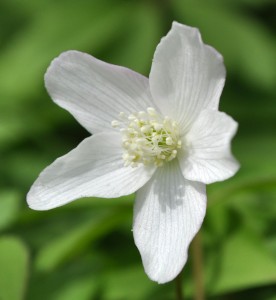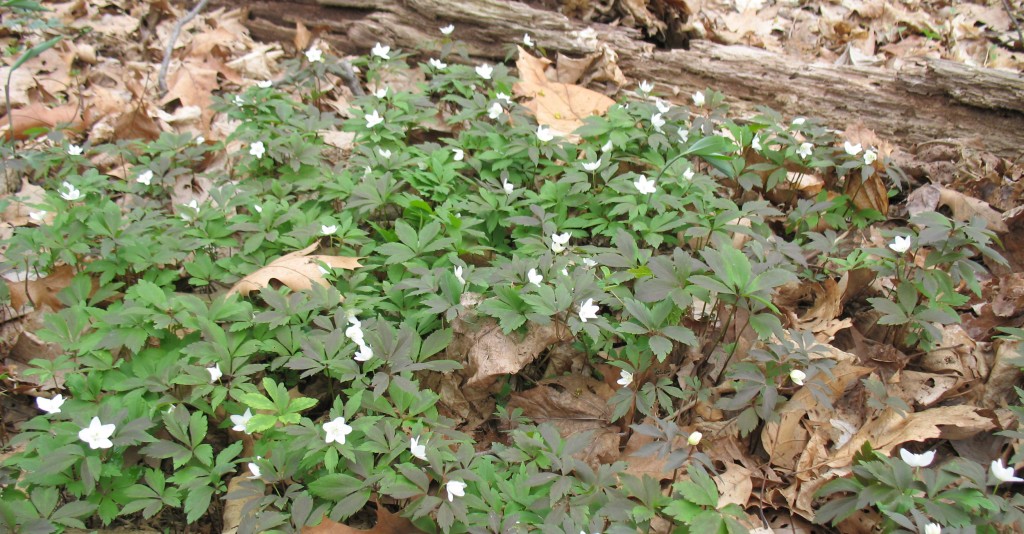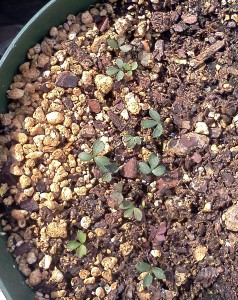The Wood Anemone: Lending a Helping Hand After 111 Years
Posted in Nuggets from the Archives on November 22, 2013 by Matthew Pace
Matthew Pace, an expert with the NYBG through 2011, is currently pursuing a Ph.D. in botany at the University of Wisconsin.

The next time you’re outdoors, take a moment and look around. What plants do you see growing nearby? Have those species always been there? Might there be plants that once grew in that area but are no longer found there? How can we help to protect the plants that we find in a given area? These are questions that many botanists and horticulturalists think about and strive to understand every day. They are central to the issues of conservation and restoration–issues which are also central to the mission of The New York Botanical Garden.
A real-world example of these issues is the case of Anemone quinquefolia and the NYBG. Based on founder Nathaniel Lord Britton’s first list of species originally found on NYBG grounds; field work in the Forest; and herbarium work I had conducted (looking through hundreds of dried plant specimens of species found in the NYC metro-area), I thought Anemone quinquefolia was just one of the 100+ native plant species which have been extirpated since the founding of the Garden (“extirpated” is a word which describes species which were once found in a location, but are no longer found there, a.k.a. local extinction). The last herbarium collections of Anemone quinquefolia were from 1898. Little did I know that I was in for the surprise of the year!
With the herbarium specimens of Anemone quinquefolia from the NYBG in hand, I thought this was just another unfortunately extirpated species. That very spring, I went for a walk on Garden grounds to see what was popping up. As I rounded the edge of a path, I happened to see a patch of leaves in the distance that was oddly bumpy and out of place. I went over (stepping carefully as I went) to investigate, gently pulling the leaves away. Amazingly, underneath the leaves appeared a large patch of Anemone quinquefolia! I could hardly believe my eyes! This beautiful plant had gone unnoticed for 111 years! I contacted Jessica Arcate Schuler, Director of the Forest in Horticulture, and Dr. Robert Naczi, Curator of North American Botany in the Herbarium, both of whom where equally elated at this rediscovery.

In my opinion, Anemone quinquefolia (Wood Anemone) is one of the most charming and beautiful of our native plants. A member of the Ranunculaceae (Buttercut Family), Anemone quinquefolia is a true perennial woodland spring ephemeral: it completes its entire life cycle–from emerging from dormancy to setting seed–in the first few weeks of spring and early summer before the canopy closes above it. The leaves emerge a deep burgundy, turning to green as the delicate white- to rose-blushed flowers open. It slowly spreads via small rhizomes in the humus-rich layer of decaying tree leaves to form patches which can reach several feet in diameter. Importantly, Anemone quinquefolia is an obligate outcrosser, meaning it can only produce viable seed when it is pollinated by an individual which is genetically distinct from itself. Because all the individuals in a population are likely to be clones (genetically identical to each other), it is therefore of crucial importance that healthy forests have multiple populations of this species in order to maximize biodiversity and allow for viable seed to be produced (this is true of many other species).
Knowing that Anemone quinquefolia needs to cross-pollinate with other populations, and seeing this as a prime candidate for restoration efforts, Jessica and I determined that we should try to obtain seeds from another local wild source; they could then be germinated and raised by the Horticulture department. Eventually these new individuals would be planted in the Forest to allow cross pollination with our original patch. I collected* seeds from multiple populations of Anemone quinquefolia found in a mesic woodland in Huntington, Long Island. It was important for us to collect seeds from nearby populations found in similar habitats in order to maintain the unique genetic identity of Anemone quinquefolia from the NYC metro area. Individuals found in a certain geographic area have adapted to their local environmental and are better-suited to grow in those conditions. If we had used seed from Anemone quinquefolia found in Georgia or Maine, the resulting plants might not have survived our cold winters or grown well in our humid summers, or they might have bloomed earlier or later than our NYBG population.
It is exhilarating to know that the combined efforts of staff from the Herbarium and Horticulture will allow this species to greet the warm spring sun for another century or more!
*: A note on collecting seeds from the wild–this should only be done by trained botanists or conservationists. Many wild flowers have suffered population declines due to overzealous harvesting of seeds and flowers. Be sure to contact your local parks department or conservation officials before collecting any wild seeds. And, of course, please do not collect seeds from The New York Botanical Garden.
A note from Jessica Arcate Schuler, Director of the Thain Family Forest

Matthew’s work has been crucial to the ongoing restoration of the Thain Family Forest. As part of The Natural History of The New York Botanical Garden, an ongoing project to document the physical setting, biota, ecology, management and ethnobotany of the Garden, Matthew has identified those species that are rare or extirpated from the Forest and require reintroduction. In the case of Anemone quinquefolia, we are working to help this species reestablish as a reproducing population within the Forest. We know that this species can grow here because it is here still and just needs a little added help. It took two trials of stratification protocols to find one that worked this past year. Right now, they are just tiny seedlings; hopefully we will have plants big enough to plant out into the Forest in the next year or two.
As for the 100+ other species on Matthew’s list, we are first interested in trying to find out why these species are no longer here and, most importantly, if they can still grow here. Matthew has documented several cases where plants were simply over-collected, however, in most cases it is not as straightforward. Perhaps soil compaction or pollution deposition of heavy metals are contributing factors. Perhaps the populations were small to begin with and simply died out as a result of a drought or an infestation of a pest or disease. The Thain Family Forest is a small remnant of the forests that once covered New York City; with increased disturbance in urban areas, it is common to have decreasing biodiversity in fragmented landscapes. We are in the process of analyzing the soils of the Forest to see if these species can still grow here. If this is the case, we look forward to establishing a reintroduction program for all compatible species on Matthew’s list for which we are able to acquire local, wild-collected seed.
This article was originally posted on May 1, 2012.

